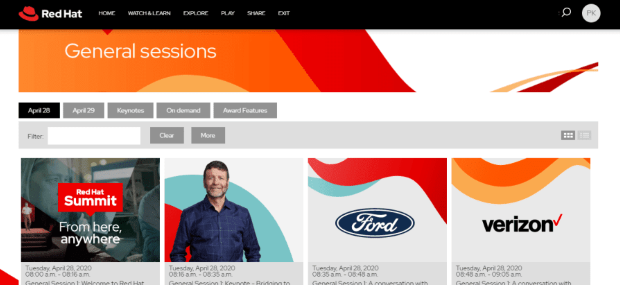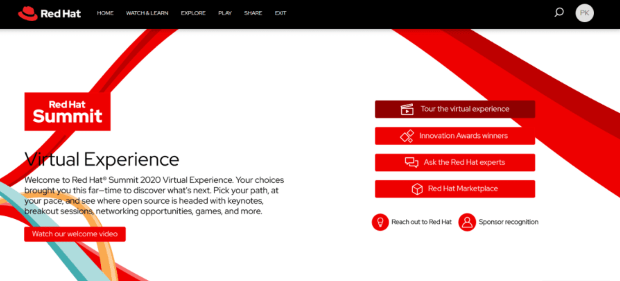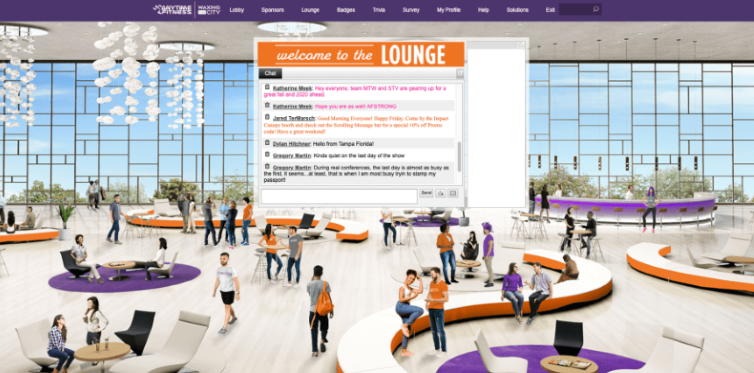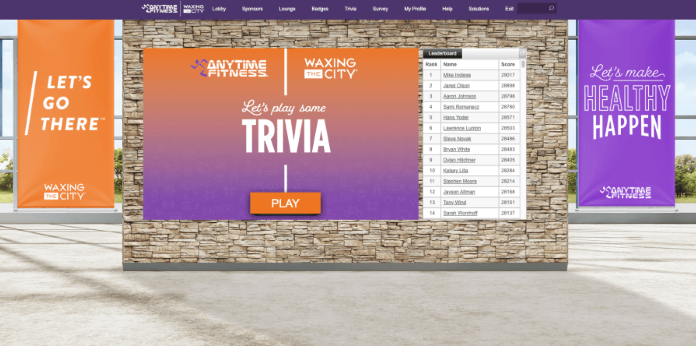Share this
How to Plan a Virtual Event: Designing Unforgettable Experiences
by Pete Kidd on Feb 28, 2023 3:26:00 PM
When considering the look and feel of your virtual event, one question you need to answer is whether to have a 2D design or a 3D environment. This decision will impact how you engage your virtual event audience.
Keep reading and learn how to choose the right design for your next virtual event.
What Is a 2D Design?
A 2D environment is based on a flat grid layout and uses simple buttons and labels—like a web page.
This design option is a bit more content forward and can typically look like an extension of your company website

Red Hat Summit’s responsive design.

Red Hat Summit’s responsive design.
What Is a 3D Environment?
A 3D environment uses angles, texture and depth to give users the feel that they’re in a three-dimensional space. A 3D environment may also use visually rich photography to make users feel like they’re walking through a convention center, an outdoor veranda or an elaborate exhibit hall.
This design option is focused more on the visual experience with the content integrated within it.

Self Esteem Brands’ 3D environment.

Self Esteem Brands’ 3D environment.
How to Use Business Goals for Guidance
Let the business goals for your virtual event drive your decision on 2D vs. 3D.
For example, is your objective to educate customers on your latest product offerings, with peer-to-peer engagement a secondary goal? A simple, responsive design may be best, so that the focus is on the educational content.
Alternatively, do you want to facilitate like-minded attendees to find one another and interact? Perhaps a 3D environment, with virtual lounges and networking areas, can facilitate this.
You also need to be honest and ask yourself: “How do you want attendees to feel?”
If the answer is “I don’t know,” or “that question isn’t relevant,” then a simple, 2D environment—or, one of the basic 3D environments provided by the virtual event platform—may suit you just fine.
If, however, you want to take attendees’ breath away—if you want to impress and wow them—then a custom-designed 3D environment may be the right answer.
Why Is the User Journey Important?
While no two virtual event user journeys are the same, we recommend that you craft the desired user journey and optimize your strategy and plan around it.
For example, do you want maximum attendance at your keynote presentation? Or, do you want to maximize visits to sponsor booths, so that exhibitors have the best lead generation results?
Perhaps you want both. What order should they happen in: keynote attendance first, followed by booth visits? Or does the sequence not matter?
Here are some ways you can guide attendees toward the desired user journeys:
-
Use the Event Schedule to Drive Actions: Users will consult the event schedule to decide what to do and when. Be intentional with the design of your schedule, keeping your desired user journey in mind. Don’t schedule your two most sought-after speakers for the same time slot, since half your audience will miss out. If you want to drive visits to sponsor booths, carve out times (e.g., 30-60 minutes or more) that are labeled as such.
-
Use Design Elements to Guide Users: The welcome area is one of the most visited spaces in a virtual event. It’s the place users land when they login. Use key navigational elements in this area to guide users where you want them to go.
-
Use Platform Features to Get Users Where You Want Them: Let’s face it: sometimes you need to escort a user to an area rather than subtly nudging them in the right direction. Use features like scheduled pop-up announcements to guide users to the next session or to a specific sponsor’s booth. Don’t assume that attendees will follow the right path. Sometimes, they need to be told what to do.
Get a Demo of Our End-to-End Event Platform
As you plan for your next event, Notified is here to help bring your vision to life.
Our leading technology is equipped with robust engagement tools ready to take your event to the next level. We are committed to the quality of your programs and supporting your needs.
Our engagement tools let you:
- Maximize ROI
- Create a unique brand experience
- Connect with a global audience
- Keep audiences engaged with interactive features
- Measure the impact of your event with analytics
Contact us today to receive a demo and learn more about our services.
Share this
- Public Relations (223)
- Press Releases (115)
- Press Release Distribution (94)
- GlobeNewswire (90)
- Investor Relations (87)
- PR Communications (73)
- Artificial Intelligence (71)
- Media Relations (49)
- IR Communications (40)
- Media Contacts Database (40)
- Global News Distribution (32)
- Webinar (31)
- IR Websites (30)
- Earnings Calls (22)
- Notified PR Platform (21)
- IR Webcasts (19)
- Experiences (17)
- Studio Webinar Platform (17)
- Virtual Events (17)
- Writing Tips (17)
- Case Study (16)
- PR Trends (16)
- Webcasts (16)
- PR Measurement (15)
- Generative AI (13)
- Media Monitoring (13)
- Event Technology (12)
- Investor Days (12)
- Webinar Strategy (12)
- ESG (10)
- Social Media (10)
- IR Event Platform (9)
- Newswire (9)
- United Kingdom (9)
- Virtual Event Platform (9)
- Accessibility (8)
- Earnings Day (8)
- Earnings Release (8)
- News Roundup (8)
- Regulatory Filing (8)
- Germany (6)
- Report (6)
- Social Listening (6)
- CLEAR Verified (5)
- IR Hub (5)
- Video (5)
- Webinar Engagement (5)
- Brand Storytelling (4)
- Misinformation (4)
- PR Agency (4)
- SEO (4)
- Trust (4)
- IR Trends (3)
- Journalism (3)
- AGM (2)
- Awards (2)
- Branding (2)
- CSR (2)
- DEI (2)
- Demand Generation (2)
- Insights & Analytics (2)
- ROI (2)
- Sentiment Analysis (2)
- Webhosting (2)
- Annual General Meeting (1)
- Canada (1)
- Capital Narratives (1)
- Emojis (1)
- Equiniti (1)
- Events (1)
- France (1)
- Halloween (1)
- Internal Communications (1)
- Internships (1)
- Life At Notified (1)
- Mark Cuban Foundation AI Bootcamp (1)
- Marketing (1)
- News Briefs (1)
- News Releases (1)
- PRSA ICON (1)
- Product Launch (1)
- Retail Investors (1)
- SXSW (1)
- Share of Voice (1)
- Sponsorships (1)
- Success Story (1)
- White Paper (1)
- eBook (1)
- September 2025 (1)
- August 2025 (6)
- July 2025 (9)
- June 2025 (12)
- May 2025 (9)
- April 2025 (11)
- March 2025 (11)
- February 2025 (6)
- January 2025 (12)
- December 2024 (12)
- November 2024 (12)
- October 2024 (14)
- September 2024 (15)
- August 2024 (14)
- July 2024 (14)
- June 2024 (14)
- May 2024 (12)
- April 2024 (13)
- March 2024 (13)
- February 2024 (15)
- January 2024 (11)
- December 2023 (7)
- November 2023 (13)
- October 2023 (14)
- September 2023 (7)
- August 2023 (8)
- July 2023 (7)
- June 2023 (8)
- May 2023 (8)
- April 2023 (5)
- March 2023 (5)
- February 2023 (8)
- January 2023 (9)

